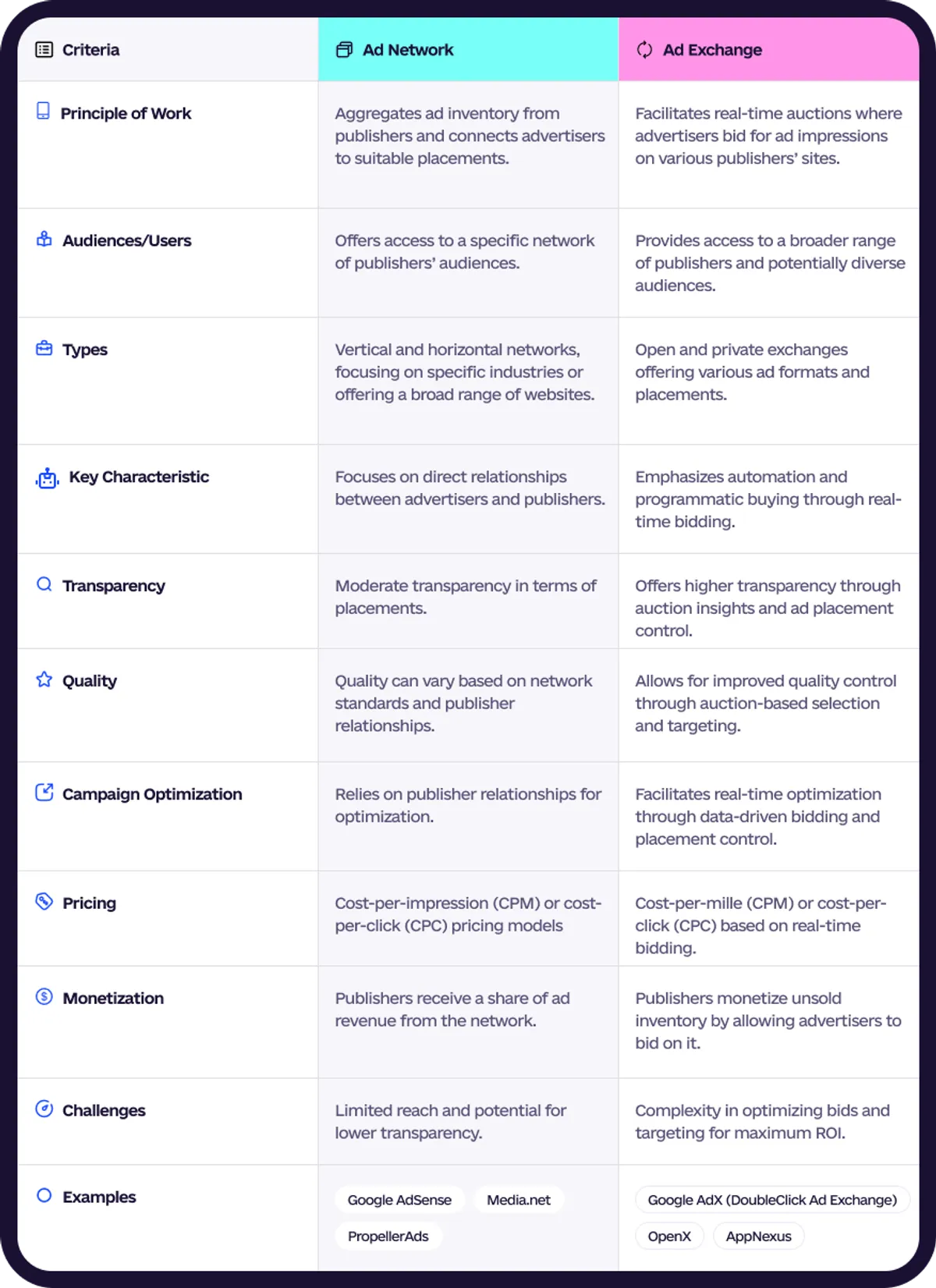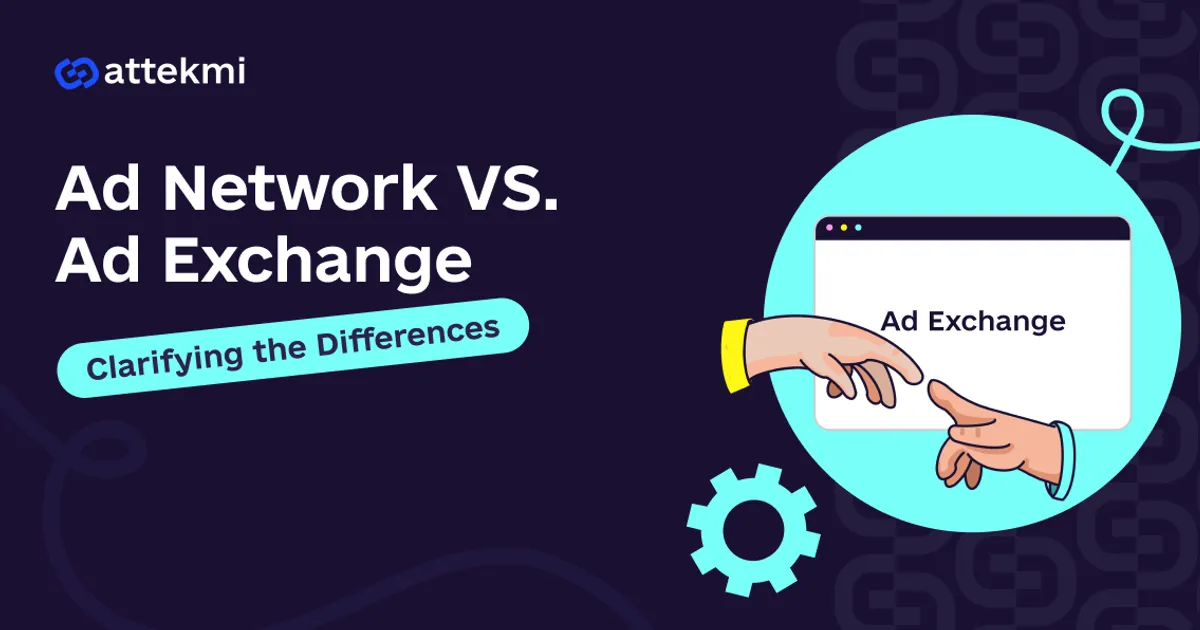The programmatic advertising ecosystem involves a range of elements. Advertisers use demand-side platforms (DSPs), while publishers leverage supply-side platforms (SSPs). An ad exchange performs as an intermediary between them. However, what is an ad network? Is it the same as an ad exchange or not?
In this guide, we will review the differences between advertising networks and exchanges, explore how an ad network works, understand their role in the AdTech industry, and not only. Keep reading to learn more.
Key Takeaways
Ad exchanges are real-time digital marketplaces where advertisers and publishers transact through automated bidding, offering transparency, control, and scalable inventory access.
Ad networks act as intermediaries that aggregate publisher inventory and resell it to advertisers, often offering managed services and thematic inventory curation.
Exchanges rely on programmatic infrastructure (DSPs/SSPs) and real-time auctions (RTB), while networks can operate without RTB and pre-package inventory based on targeting segments.
Both models offer benefits: exchanges provide dynamic optimization and direct trading; networks deliver simplicity, expert support, and broader audience reach.
Attekmi delivers white-label ad exchanges and custom-built ad networks tailored to your business needs, combining automation, compliance, and scalability for programmatic success.
What is an ad exchange?
An ad exchange is a digital marketplace connecting advertisers and publishers – this is where real-time auctions take place. It processes the bids from DSPs and notifies an ad server when the winning bid is identified. This way, an ad exchange is an integral part of programmatic advertising. One example of such a platform is the ad exchange solution AdEx Enterprise, designed to handle high-volume, real-time bidding with efficiency and scale.
How do ad exchanges work?
At the heart of the digital advertising landscape lies a complex network that seamlessly connects enterprises seeking online visibility with publishers offering advertising prospects. One standout example is Google AdSense, which revolutionizes brand-customer connections in the virtual realm.
Imagine a dynamic AdTech ecosystem where businesses of all sizes tap into the Internet’s potential to reach their ideal audiences. Functioning as a conduit, this ad network directs advertisers’ objectives toward publisher platforms.
Google AdSense, a prime player, seamlessly integrates ads into various websites, granting businesses unprecedented visibility. This alliance isn’t just about connectivity; technology underpins the journey. The ad buying process is now swift and streamlined. Precise targeting, especially behavioral targeting, adds another layer of sophistication.
Ad exchanges and ad networks share a fundamental similarity, carrying out akin roles. However, ad networks took the lead historically, accumulating inventory pre-RTB and programmatic eras. This amassed inventory was later categorized and made available to advertisers. Ad networks possess the capability to organize inventory into distinct categories based on specific audience segments.
Conversely, exchanges integrate connected DSPs and SSPs predominantly, operating primarily on the RTB framework. In contrast, networks can operate without algorithmic buying systems.
Benefits of ad axchanges
Streamlined auctions: real-time bidding enhances ad positioning for maximum value;
Focused targeting: advertisers have the ability to target precise demographics and contexts;
Varied inventory: accessing multiple platforms aids in reaching a wide range of audiences;
Control: advertisers have campaign control and flexibility;
Data insights: real-time analytics aid decision-making;
Transparency: visibility into ad placement fosters trust;
Cost efficiency: competitive prices maximize ad spend value;
Automation: streamlined processes improve efficiency;
Magnitude and outreach: worldwide inventory amplifies campaign scope;
Real-time optimization: continuous adjustments enhance ad impact.
What is an ad network?
An ad network is a platform that acts on behalf of publishers. It represents media owners in the programmatic ecosystem, groups their ad space, and then sells it (most often, via auctions). Unlike an ad exchange, a network is not a mandatory participant of a media buying process.
How do ad networks work?
Explaining the differences between ad networks and exchanges, it`s important to note that ad networks are inherently predecessors to the emergence of ad exchanges, even if talk about top ad networks for publishers. These platforms represent the very essence of the marketplace, where publishers and advertisers engage in a strategic dance, constantly moving across the supply and demand stage.
This interconnected network, exemplified by industry giants such as Google DoubleClick Ad Exchange and Microsoft Advertising Exchange, seamlessly harmonizes the intricate interaction between advertisers seeking optimal exposure and publishers offering prime advertising real estate. This innovative ecosystem reshapes the landscape of online promotion, ushering in a new era of efficiency, precision, and value exchange.
Publishers exhibit their sought-after ad space while advertisers armed with data-driven approaches vie for top-tier positions. The platform automates the bidding process, as a result of which the most favorable offer leads to winning the bid and getting or selling advertising space.
Fundamentally, an ad network functions as a firm that serves as a mediator connecting publishers and advertisers. Its role involves managing communication and transactions, streamlining the process for its clientele.
Benefits of ad networks
Wider reach: entry to a variety of websites and platforms to enhance audience engagement on a broader scale;
Efficiency: the efficient process of buying and selling ads streamlines tasks and conserves time and energy;
Precise targeting: advanced options to reach specific demographics and behaviors;
Affordability: cost-effective solutions suitable for various budgets;
Expert support: access to experts for crafting effective campaigns;
Versatile formats: support for multiple ad formats, from display to video;
Real-time analytics: monitoring campaign performance in real time for adjustments;
Brand safety: measures in place to ensure ads appear on reputable sites;
Cross-platform reach: extending campaigns seamlessly across devices and platforms;
Scalability: accommodates campaigns of all sizes for flexibility;
Testing and optimization: allows experimentation and refining for optimal results.
Ad network vs ad exchange: detailed comparison
Let’s review the difference between an ad exchange and ad network in detail.

Please note that this table provides a general overview, and the specifics of each ad network and ad exchange may vary.
How ad networks and ad exchanges coexist in the modern AdTech stack
Both ad networks and exchanges have their specific benefits, so they keep coexisting successfully – the choice depends on business needs and the nuances of an advertising strategy. While ad exchanges are something that a programmatic environment cannot function without, ad networks are an optional choice. Many advertisers use them to access a wider pool of publishers. In turn, media owners may leverage networks focusing on topic-specific inventory, ad space of certain formats, etc. In this context, understanding martech vs adtech becomes important, as it helps clarify the distinct roles each technology plays in shaping effective advertising solutions.
Ad exchange vs. ad network: what is better for your business
It is difficult to answer the question of “what is better” definitively. Each business has its own needs and may prioritize different criteria by which to choose an advertising interaction model.
However, ad exchanges and networks can be used not only by advertisers and publishers. By owning such a platform, you can drive media trading income. Again, to choose between an exchange and a network, it is essential to consider your goals and requirements, as well as the differences between the solutions.
Note that building such a platform from scratch can be expensive and time-consuming. Fortunately, Attekmi is here to help. We offer several ad exchange solutions, including the White Label one – it gets tailored to your needs, from UI personalization to on-request custom feature development. Additionally, we offer custom AdTech development services and can build an ad network for you.
Explore the case studies of our partners to find out what heights you can reach with our solutions.
The future of ad buying: are ad exchanges replacing ad networks?
The programmatic industry is evolving continuously, so here are a few trends projected to have an impact on ad networks and exchanges in the near future:
SPO. Striving for greater transparency, the players of the AdTech industry tend to follow supply-path optimization practices. This involves reducing the number of intermediaries, which can start affecting ad networks at some point.
Privacy regulations. Since privacy-related laws are getting stricter, contextual advertising is on the rise. This can be beneficial for networks that are able to collect enough useful data about publishers, but a disadvantage for those that cannot.
AI and ML. Artificial intelligence and machine learning will further enhance the media buying process. For networks, the technology can introduce more innovative ways to analyze the data.
At the moment, ad exchanges are not replacing ad networks. However, the current and future trends can affect the way they work.
Final thoughts
In conclusion, recognizing the disparity between an ad network vs exchange offers substantial benefits as you traverse the constantly evolving landscape of digital advertising.
The choice depends on your specific needs. For publishers, an ad network can act as an effective intermediary. In turn, advertisers benefit from a varied range of publishers and their inventory.
In turn, ad exchanges enable greater control. Besides, the reduced number of intermediaries implies enhanced transparency.
Now you have the comparative analysis of ad exchange versus ad network, and a fundamental description of the difference between ad network and ad exchange. Therefore, you can make an informed choice and make the most of your programmatic campaigns.
At Attekmi, we offer a wide range of ad exchange solutions. Contact us to choose your perfect platform.
FAQ
What is the difference between an ad exchange and an ad network?
An ad network establishes links between advertisers and publishers, facilitating access to the sites’ various advertising resources. An ad exchange, on the other hand, operates as an instant marketplace where advertisers and publishers participate in auctions to sell specific ad impressions. Compared to ad networks, exchanges offer greater control and targeting capabilities.
What are the examples of ad networks and exchanges?
Ad Network examples: Google AdSense, Media.net, AdMob. Ad Exchange examples: OpenX, DoubleClick Ad Exchange (now Google Ad Manager), Rubicon Project.
What is better for business?
The choice between an ad network and an ad exchange depends on your business goals. Ad networks offer simplicity and broad reach, ideal for easy campaign management. Ad exchanges provide precise targeting and control, suitable for optimizing ad placements and maximizing returns. Consider your objectives and the level of customization needed to decide which is better for your business.
 By Anastasiia Lushyna
By Anastasiia Lushyna

